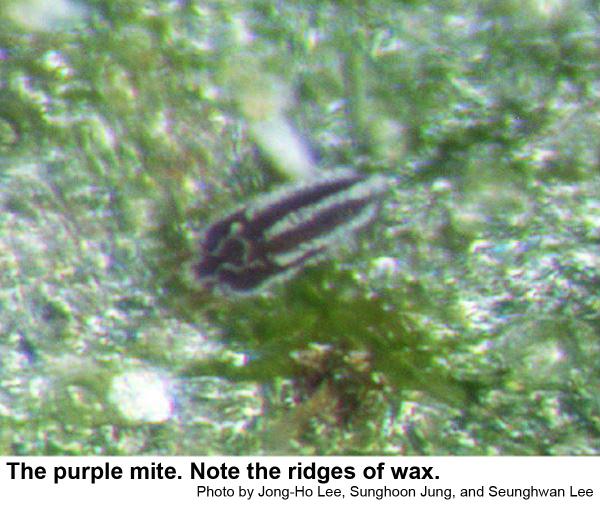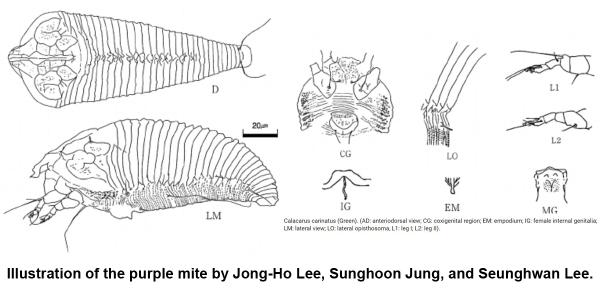Description and Biology
The purple mite, Calacarus carinatus, is also known as the purple camellia mite, the purple tea mite (camellia and tea are closely related plants), and ribbed mite. Purple mites are, indeed, purple, but they are virtually microscopic. These mites are shaped like the snack food called "Bugles" with four legs and mouthparts at the large end. They have five ridges of white wax down the body. These mites lay eggs from with hatch nymphs that molt twice as they grow. Most of the eggs are laid along veins. The life cycle on tea depends on temperature. During January they develop in 13 to14 days, in hot weather 7 days. The empty egg shells and cast skins can give heavily infested leaves a dusty appearance. Purple mites have scissor-like mouthparts with which they pierce leaves to inject their saliva before they suck out a sort of predigested "soup." Purple mites are in the group of eriophyids called rust mites and vagrants (as opposed to gall mites), and they spend most of their lives exposed on the leaves, especially on the lower leaf surface. In hot, humid weather, these mites often succumb to a parasitic fungus, Hirsutella thompsonii, so that populations of living mites decrease to very low levels by late summer. With cooler, drier weather in the fall, the surviving female mites develop into an aestivating stage that overwinters in bud scales and other cracks and crevices on the host plants.
Host Plants
Camellia (Camellia Japonica), Camellia caudata, Camellia kissi, and tea (Camellia sinensis) are typical hosts, but purple mites have been collected from bell pepper, Spathiphyllum, Guelder rose (Viburnum opulus) and other Viburnums. They leave white, cast skins and cause bronzing on both leaf surfaces. Aside from the mechanical damage, their saliva can also cause plant growth regulator activity, causing infested leaves to turn purple between the veins before russeting and bronzing. Damaged leaves eventually turn brown and drop prematurely.
Residential Recommendations
One encouraging characteristic of eriophyid mites is that they are susceptible to the pesticide Sevin. Sevin is widely used in vegetable gardens, flea powder, and even slug baits. I recommend spraying infested camellias with Sevin on the next convenient day. If a sprayable formulation of Sevin is not available, most of the pesticides labeled for home landscape use should give adequate control.
Other Resources
- An ecological study of the tea purple mite, Calacarus carinatus Green. Shiao, S.N. 1976. Plant Protection Bulletin (Taiwan) 18(2): 183-198.
- A New Pest of Spathiphyllum! Calacarus carinatus (Green) (Acari: Eriophyidae): Purple or Ribbed Tea mite. Anonymous. No Date. Mid-Florida Research and Education Center - University of Florida
- Camellia Purple Mite (Ribbed Tea Mite)-Calacarus carinatus. Smith, S. and R. Corder. 2016. Univ. Arkansas Division of Agriculture Research and Extension.
- Eriophyoid mites (Acari, Eriophyoidea) associated with tea plants, with descriptions of a new genus and two new species. Xiao Han, Yun Zuo, Xiao-Feng Xue, and Xiao-Yue Hong. 2015. ZooKeys. (534): 1–16.
- Purple mite: Calacarus carinatus. Anonymous. 2015. TNAU Agritech Portal, Crop Protection.
- Purple tea mite (Calacarus carinatus). Plantwise Knowledge Bank. No Date. CABI plantwise.
- Three Newly Recorded Species of the Genera Acaphylla Keifer and Calacarus Keifer (Prostigmata: Eriophyidae) from Camellia spp. (Theaceae) in Korea. Lee, J.-H., Jung, S. and S. Lee. 2014. Korean J. Appl. Entomol. 53(1): 59-64.
- Extension Plant Pathology Publications and Factsheets
- Horticultural Science Publications
- North Carolina Agricultural Chemicals Manual
For assistance with a specific problem, contact your local N.C. Cooperative Extension Center.
This Factsheet has not been peer reviewed.
Publication date: Dec. 12, 2018
Reviewed/Revised: Sept. 22, 2023
Recommendations for the use of agricultural chemicals are included in this publication as a convenience to the reader. The use of brand names and any mention or listing of commercial products or services in this publication does not imply endorsement by NC State University or N.C. A&T State University nor discrimination against similar products or services not mentioned. Individuals who use agricultural chemicals are responsible for ensuring that the intended use complies with current regulations and conforms to the product label. Be sure to obtain current information about usage regulations and examine a current product label before applying any chemical. For assistance, contact your local N.C. Cooperative Extension county center.
N.C. Cooperative Extension prohibits discrimination and harassment regardless of age, color, disability, family and marital status, gender identity, national origin, political beliefs, race, religion, sex (including pregnancy), sexual orientation and veteran status.


